 Recently I have been able to get into the fields, and the best way to describe my experiences would be: muddy. Its been so nice to see this much moisture in the fields, and I have seen some very good looking corn driving to and from fields. The first three weeks of squaring is the time to be on the lookout for cotton fleahoppers. These insects are a small, pale green plant bug that tends to be pretty skittish. The adults (top image at left) will fly if startled, and generally will not hang around on the plant for a long time for you to get a good look at them while scouting. The nymphs (lower image at left)the action threshold is 15- 25 fleahoppers per 100 plant terminals checked. The chart below contains insecticide suggestions from cottonbugs.tamu.edu (also a very good resource) for reference if you have fleahoppers at the action threshold.
Recently I have been able to get into the fields, and the best way to describe my experiences would be: muddy. Its been so nice to see this much moisture in the fields, and I have seen some very good looking corn driving to and from fields. The first three weeks of squaring is the time to be on the lookout for cotton fleahoppers. These insects are a small, pale green plant bug that tends to be pretty skittish. The adults (top image at left) will fly if startled, and generally will not hang around on the plant for a long time for you to get a good look at them while scouting. The nymphs (lower image at left)the action threshold is 15- 25 fleahoppers per 100 plant terminals checked. The chart below contains insecticide suggestions from cottonbugs.tamu.edu (also a very good resource) for reference if you have fleahoppers at the action threshold.of these insects are also quite small, about the size of an aphid. They are also a pale green color, but lack wings. They nymphs can be easy to confuse with the nymphs of minute pirate bugs, but the minute pirate bug nymphs tend to be orange and are shaped more like a teardrop. Fleahopper nymphs lack the bands on the antennae a few other species of plant bugs have, and have a similar body shape to the adult bug. Their feeding on squares in cotton will leave a puncture mark in the square and cause it to dry up and drop off. I have been seeing fleahoppers in Wharton, Jackson, and Matagorda counties, but only in low numbers so far. Checking a field once a week will work for catching fleahoppers. If you are seeing fleahoppers in field,
Most of the sorghum planted this year is fairly early, so a great deal of it may have already escaped the sorghum midge. This insect lays eggs in the florets of blooming sorghum. They only live as an adult for a single day, but one female can lay about 50 eggs during that day. To sample for midge, use a white bucket as a "beat bucket" by beating the flowering sorghum head on the sides of the bucket. Check for the tiny red insect inside the bucket, if they were in the grain head they will be stuck to the sides of the bucket. Look at a minimum of 20 sorghum heads per 20 acres to check for midges. The economic threshold for sorghum midges is the formula listed below. Be careful if you are needing to control midges with a pyrethroid, if there are aphids present their populations can flare.

Sugarcane aphid populations have been fairly high down in the valley and in Corpus Christi, and there have been reports of yellow sugarcane aphid populations high enough to warrant spraying. I have seen more yellows in Wharton, Jackson and Matagorda counties this year, but keep an eye out for both aphids. There have been a few fields sprayed in our area for both this year already. Check the underside of the leaves for both aphids, yellows tend to be toward the bottom of the plant. If yellow sugarcane aphids are only on the bottom leaves, there is no need to treat yet. If they begin moving into the upper canopy, then it is time to consider treatment options, as 5-6 aphids feeding can kill a leaf. Sugarcane aphids, the ones with the "black tailpipes", should be checked for once a week, until they are found on lower or mid canopy leaves, then they should be checked twice weekly. If the infestation gets higher than 50-125 aphids or more per leaf, treatment should be made within 4 days, and evaluated again in 3-4 days. Additional information and pictures of the aphids and quick check guide can be found at:
Yellow Sugarcane Aphids Sugarcane Aphids
Kate




No comments:
Post a Comment